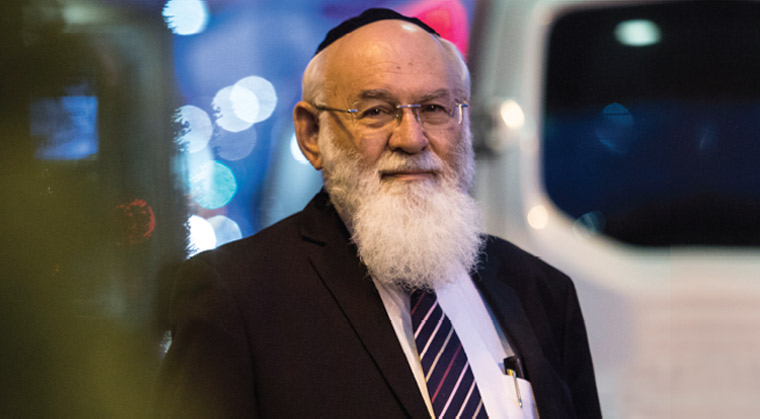Doctor at the Crossroads


Rabbi Dr. Steinberg is the senior pediatric neurologist at Jerusalem’s Shaare Zedek Medical Center, where he also directs the medical ethics unit, and he also teaches medical ethics at Hebrew University’s medical school. In addition, he co-chairs Israel’s National Bioethics Council and sits on numerous other governmental and professional committees… Hard as it is to imagine, in his “spare time,” he also heads the editorial board of the Encyclopedia Talmudis (Photos: Amir Levy)
When it was his turn to speak at the Orthodox Union’s second annual Torah New York event at Citi Field last month, the renowned Israeli medical ethicist Rabbi Dr. Avraham Steinberg opened his session on end-of-life halachic issues with a bit of dark humor.
People have conflicting attitudes about prolonging life in its final stages, he said, and proceeded to illustrate the point with two stories. “They tell of three fellows who were discussing what they hoped people would say at their funerals. One says, ‘I hope they describe my good deeds,’ another says, ‘I hope they talk about my good heart,’ and then the third chimes in, ‘I hope they say, “Look, he’s moving!” ’ ”
On the other hand, Dr. Steinberg continued, “there’s the story of the doctor telling the wife of a long-suffering patient, ‘I’m sorry to say it’s only a matter of days until your husband will leave us.’
“To which she responds, ‘I’ve waited this long, I can wait a little longer.’ ”
The hourlong presentation that followed was a classic tour de force, putting on display the mastery of halachic sources and cutting-edge medical expertise that have made Rabbi Dr. Steinberg a go-to authority worldwide on issues at the interface of halachah and medicine. But truth to tell, the humorous lead-in was a bit stilted, and for a simple reason: Although he appreciates a good joke, Dr. Steinberg is a serious man whose work addresses issues that are no laughing matter, questions of life and death, and serious illness, and ethical dilemmas of the highest gravity.
He is, in fact, something of a rarity in the Israel of today: a genuine public intellectual whose influence is felt across the diverse gamut of Israeli society. A talmid chacham of note and a man of science, Rabbi Dr. Steinberg is as comfortable in a university lecture hall or Knesset committee meeting as he is in the homes of the leading poskim with whom he regularly consults. He’s the senior pediatric neurologist at Jerusalem’s Shaare Zedek Medical Center, where he also directs the medical ethics unit, and he also teaches medical ethics at Hebrew University’s medical school. In addition, he co-chairs Israel’s National Bioethics Council and sits on numerous other governmental and professional committees.
But the secret to his entrיe into so many circles may lie not only in his intellectual acumen and breadth of knowledge, but also in the personal chein he exudes and the calm, quietly upbeat demeanor that immediately sets one at ease with him.
Hard as it is to imagine, in his “spare time,” this consummately busy man also heads the editorial board of the sprawling Torah publishing project known as the Encyclopedia Talmudis. Sitting down with Dr. Steinberg for a conversation following the OU event, I wonder aloud: Where does a practicing physician and professor, an author and editor of 36 books and hundreds of articles, who has shepherded legislation through the Knesset and served as an expert witness in thousands of court cases, find the time to direct one of the world’s premier projects of Torah scholarship?
He readily admits that when he was first asked to take on a role at the encyclopedia ten years ago, he had no idea of how enormous an undertaking it would turn out to be. Feeling grateful for all he had personally gained over the years from the masterwork of research that is the Encyclopedia Talmudis, he agreed to get involved. A decade later, finding himself at the helm of something he refers to as “probably the most important Torah project of our generation,” he has no regrets.
The Encyclopedia got its start in Eretz Yisrael during World War II when, with the Nazis slaughtering Torah students in the thousands and destroying every last vestige of Europe’s yeshivos, the very future of Torah transmission to coming generations seemed imperiled. The project’s first editor-in-chief was Rav Shlomo Yosef Zevin, whose fluency in Shas and rare talent for writing with clarity and concision enabled him to distill the essence of many pages of a Torah work into a pithy few paragraphs.
Oops! We could not locate your form.






